Ecological Network Optimization in Urban Central District Based on Complex Network Theory: A Case Study with the Urban Central District of Harbin
Abstract
:1. Introduction
2. Materials and Methods
2.1. Study Area
2.2. Data Sources
2.3. Methods
2.3.1. Landscape Pattern Analysis
2.3.2. Extraction of Ecological Network
2.3.3. Optimization of Ecological Network
2.3.4. Optimization Effect Test of Ecological Network
3. Results and Discussion
3.1. Analysis of Landscape Pattern of Ecological Patches in the Study Area
3.2. Construction of Ecological Network in the Study Area
3.2.1. Identification of Ecological Sourcess
3.2.2. Extraction of Ecological Corridors
3.3. Robustness Analysis of Ecological Network before and after Optimization
3.3.1. Robustness Analysis of Ecological Network before Optimization
3.3.2. Robustness Analysis of Ecological Network after Optimization
3.4. LDF-Based Ecological Network Optimization in the Study Area
4. Conclusions
Author Contributions
Funding
Institutional Review Board Statement
Informed Consent Statement
Data Availability Statement
Acknowledgments
Conflicts of Interest
Appendix A
| Primary Factor | Secondary Factor | Grade | Ecological Resistance |
|---|---|---|---|
| Land cover | Land use type | Urban land, rural settlement, other construction land | 9 |
| Beach, saline-alkali land, bare land | 7 | ||
| Paddy field, dry land, | 5 | ||
| Sparse forest, other woodland, canal, medium coverage grassland, marsh | 3 | ||
| Forestland, high coverage grassland, lake, reservoir, bush, | 1 | ||
| Terrain factor | DEM | 0–1000 m | 9 |
| 1000–1300 m | 7 | ||
| 1300–1500 m | 5 | ||
| 1500–1700 m | 3 | ||
| >1700 m | 1 | ||
| SLOPE | 0–3 | 9 | |
| 3–9 | 7 | ||
| 9–18 | 5 | ||
| 18–27 | 3 | ||
| >27 | 1 | ||
| Hydrological factor | MNDWI | <0 | 9 |
| 0–0.22 | 7 | ||
| 0.22–0.6 | 5 | ||
| 0.6–0.8 | 3 | ||
| >0.8 | 1 | ||
| Vegetation cover | NDVI | <0 | 9 |
| 0–0.2 | 7 | ||
| 0.2–0.33 | 5 | ||
| 0.33–0.6 | 3 | ||
| >0.6 | 1 | ||
| Traffic factor | Road network density | >1.25 | 9 |
| 0.85–1.25 | 7 | ||
| 0.52–0.85 | 5 | ||
| 0.20–0.52 | 3 | ||
| 0–0.20 | 1 |
References
- Wei, S.; Pan, J.; Liu, X. Landscape ecological safety assessment and landscape pattern optimization in arid inland river basin: Take Ganzhou District as an example. Hum. Ecol. Risk Assess. Int. J. 2018, 26, 782–806. [Google Scholar] [CrossRef]
- Gong, Z.; Wang, L. On consistency test method of expert opinion in ecological security assessment. Int. J. Environ. Res. Public Health. 2017, 14, 1012. [Google Scholar] [CrossRef] [PubMed] [Green Version]
- Wang, Q.; Yuan, X.; Zuo, J.; Zhang, J.; Hong, J.; Lin, C. Optimization of Ecological Industrial Chain design based on reliability theory–a case study. J. Clean. Prod. 2016, 124, 175–182. [Google Scholar] [CrossRef]
- Shi, F.; Liu, S.; An, Y.; Sun, Y.; Zhao, S.; Liu, Y.; Li, M. Spatio-Temporal Dynamics of Landscape Connectivity and Ecological Network Construction in Long Yangxia Basin at the Upper Yellow River. Land 2020, 9, 265. [Google Scholar] [CrossRef]
- Guo, R.; Wu, T.; Liu, M.; Huang, M.; Stendardo, L.; Zhang, Y. The Construction and Optimization of Ecological Security Pattern in the Harbin-Changchun Urban Agglomeration, China. Int. J. Environ. Res. Public Health 2019, 16, 1190. [Google Scholar] [CrossRef] [PubMed] [Green Version]
- Yu, Q.; Yue, D.; Wang, Y.; Kai, S.; Fang, M.; Ma, H.; Zhang, Q.; Huang, Y. Optimization of ecological node layout and stability analysis of ecological network in desert oasis: A typical case study of ecological fragile zone located at Deng Kou County(Inner Mongolia). Ecol. Indic. 2018, 84, 304–318. [Google Scholar] [CrossRef]
- Peng, J.; Zhao, H.; Liu, Y. Urban ecological corridors construction: A review. Acta Ecol. Sin. 2017, 37, 23–30. [Google Scholar] [CrossRef]
- Shi, Y.; Song, H.; Shang, M.; Shao, M.; Lei, H. Analysis of Land Cover and Landscape Pattern Change in Beijing-Tianjin-Hebei Region Based on Globeland30 Data. J. Geogr. Inf. Syst. 2020, 12, 241–255. [Google Scholar] [CrossRef]
- Carlier, J.; Moran, J. Landscape typology and ecological connectivity assessment to inform Greenway design. Sci. Total Environ. 2019, 651, 3241–3252. [Google Scholar] [CrossRef]
- Forman, R.T.; Godron, M. Landscape Ecology; John Wiley & Sons: Hoboken, NJ, USA, 1986. [Google Scholar]
- Shi, F.; Liu, S.; Sun, Y.; An, Y.; Zhao, S.; Liu, Y.; Li, M. Ecological network construction of the heterogeneous agro-pastoral areas in the upper Yellow River basin. Agric. Ecosyst. Environ. 2020, 302, 107069. [Google Scholar] [CrossRef]
- Cui, L.; Wang, J.; Sun, L.; Lv, C. Construction and optimization of green space ecological networks in urban fringe areas: A case study with the urban fringe area of Tongzhou district in Beijing. J. Clean. Prod. 2020, 276, 124266. [Google Scholar] [CrossRef]
- Mukherjee, K.; Pal, S. Hydrological and landscape dynamics of floodplain wetlands of the Diara region, Eastern India. Ecol. Indic. 2021, 121, 106961. [Google Scholar] [CrossRef]
- Zhou, Y.; Zhang, Q. Impacts of road networks on species migration and landscape connectivity. Chin. J. Ecol. 2014, 33, 440–446. [Google Scholar] [CrossRef]
- Yang, J.; Zeng, C.; Cheng, Y. Spatial influence of ecological networks on land use intensity. Sci. Total Environ. 2020, 717, 137151. [Google Scholar] [CrossRef] [PubMed]
- Zhao, S.-M.; Ma, Y.-F.; Wang, J.-L.; You, X.-Y. Landscape pattern analysis and ecological network planning of Tianjin City. Urban For. Urban Green. 2019, 46, 126479. [Google Scholar] [CrossRef]
- Shin, G.; Kim, H.-R.; Jang, S.-R.; Kim, H.-Y.; Rho, P. Evaluating the Criteria and Weight Value for Ecological Network Connectivity of Baekdudaegan Mountain Range on Taebaeksan National Park. Korean J. Environ. Ecol. 2019, 33, 292–302. [Google Scholar] [CrossRef]
- Zamberletti, P.; Zaffaroni, M.; Accatino, F.; Creed, I.F.; De Michele, C. Connectivity among wetlands matters for vulnerable amphibian populations in wetlandscapes. Ecol. Model. 2018, 384, 119–127. [Google Scholar] [CrossRef]
- McDonnell, M.J.; Pickett, S.T.A.; Groffman, P.M.; Bohlen, P.; Pouyat, R.V.; Zipperer, W.C.; Parmelee, R.W.; Carreiro, M.M.; Medley, K. Ecosystem processes along an urban-to-rural gradient. Urban Ecosyst. 1997, 1, 21–36. [Google Scholar] [CrossRef]
- Pascual-Hortal, L.; Saura, S. Integrating landscape connectivity in broad-scale forest planning through a new graph-based habitat availability methodology: Application to capercaillie (Tetrao urogallus) in Catalonia (NE Spain). Eur. J. For. Res. 2007, 127, 23–31. [Google Scholar] [CrossRef]
- Yi, Y.; Tang, C.; Yi, T.; Yang, Z.; Zhang, S. Health risk assessment of heavy metals in fish and accumulation patterns in food web in the upper Yangtze River, China. Ecotoxicol. Environ. Saf. 2017, 145, 295–302. [Google Scholar] [CrossRef]
- Slota, G.M.; Madduri, K.; Rajamanickam, S. Complex Network Partitioning Using Label Propagation. SIAM J. Sci. Comput. 2016, 38, S620–S645. [Google Scholar] [CrossRef] [Green Version]
- Fan, R.; Dong, L.; Yang, W.; Sun, J. Study on the optimal supervision strategy of government low-carbon subsidy and the corresponding efficiency and stability in the small-world network context. J. Clean. Prod. 2017, 168, 536–550. [Google Scholar] [CrossRef]
- Zhang, W.; Han, G.; Feng, Y.; Lloret, J.; Shu, L. A Survivability Clustering Algorithm for Ad Hoc Network Based on a Small-World Model. Wirel. Pers. Commun. 2015, 84, 1835–1854. [Google Scholar] [CrossRef]
- Peng, J.; Yang, Y.; Liu, Y.; Hu, Y.; Du, Y.; Meersmans, J.; Qiu, S. Linking ecosystem services and circuit theory to identify ecological security patterns. Sci. Total Environ. 2018, 644, 781–790. [Google Scholar] [CrossRef] [Green Version]
- Hou, H.B.; Guo, H.Q.; Yu, Q.; Long, Q.Q.; Pei, Y.R.; Yue, D.P. Analysis of Ordos Landscape Pattern and Spatial Optimization. Chin. J. Agric. Mach. 2020, 51, 205–212. [Google Scholar] [CrossRef]
- Xuan, L.; Ma, Y.; Xing, Y.; Meng, Q.; Song, J.; Chen, T.; Wang, H.; Wang, P.; Zhang, Y.; Gao, P. Source, temporal variation and health risk of volatile organic compounds (VOCs) from urban traffic in harbin, China. Environ. Pollut. 2021, 270, 116074. [Google Scholar] [CrossRef]
- Yuanjing, Z.; Binyang, Y.; Ashraf, M.A. Ecological security pattern for the landscape of mesoscale and microscale land: A case study of the harbin city center. J. Environ. Eng. Landsc. Manag. 2015, 23, 192–201. [Google Scholar] [CrossRef]
- Shi, X.W.; Feng, G.J.; Yi, Y.; Zou, Y.J.; Ge, H.H.; Su, P.T. Temporal and spatial evolution characteristics of land use pattern and ecological risk assessment of urban agglomeration in central Zhejiang. Chin. J. Agric. Mach. 2020, 51, 242–251. [Google Scholar] [CrossRef]
- Gong, J.; Xie, Y.; Cao, E.; Huang, Q.; Li, H. Integration of InVEST-habitat quality model with landscape pattern indexes to assess mountain plant biodiversity change: A case study of Bailongjiang watershed in Gansu Province. J. Geogr. Sci. 2019, 29, 1193–1210. [Google Scholar] [CrossRef] [Green Version]
- Meng, C.; Wang, J.P.; Zhi, X.R.; Hu, Y.P.; Zhang, D.C.; Wang, L.R. Search on spatial Pattern Rank Characteristics of County Forest Landscape based on GIS. Chin. J. Agric. Mach. 2008, 49, 187–194. [Google Scholar] [CrossRef]
- Estoque, R.C.; Murayama, Y. Landscape pattern and ecosystem service value changes: Implications for environmental sustainability planning for the rapidly urbanizing summer capital of the Philippines. Landsc. Urban Plan. 2013, 116, 60–72. [Google Scholar] [CrossRef]
- Han, L.; Zhou, W.; Li, W.; Li, L. Impact of urbanization level on urban air quality: A case of fine particles (PM 2.5) in Chinese cities. Environ. Pollut. 2014, 194, 163–170. [Google Scholar] [CrossRef]
- Ariken, M.; Zhang, F.; Liu, K.; Fang, C.; Kung, H.-T. Coupling coordination analysis of urbanization and eco-environment in Yanqi Basin based on multi-source remote sensing data. Ecol. Indic. 2020, 114, 106331. [Google Scholar] [CrossRef]
- Li, Y.; Li, Y.; Zhou, Y.; Shi, Y.; Zhu, X. Investigation of a coupling model of coordination between urbanization and the environment. J. Environ. Manag. 2012, 98, 127–133. [Google Scholar] [CrossRef]
- Dai, L.; Liu, Y.; Luo, X. Integrating the MCR and DOI models to construct an ecological security network for the urban agglomeration around Poyang Lake, China. Sci. Total Environ. 2021, 754, 141868. [Google Scholar] [CrossRef]
- Jin, G.; Shi, X.; He, D.; Guo, B.; Li, Z.; Shi, X. Designing a spatial pattern to rebalance the orientation of development and protection in Wuhan. J. Geogr. Sci. 2020, 30, 569–582. [Google Scholar] [CrossRef]
- Ma, J.L. Research on Optimization Strategy of Complex Network Information Capacity; Harbin Institute of Technology: Harbin, China, 2016. [Google Scholar]
- Wang, J.; Jiang, C.; Qian, J. Robustness of interdependent networks with different link patterns against cascading failures. Phys. A Stat. Mech. Appl. 2014, 393, 535–541. [Google Scholar] [CrossRef]
- Jiang, Z.; Liang, M.-G.; Guo, D. Improving network transport efficiency by edge rewiring. Mod. Phys. Lett. B 2013, 27, 1350056. [Google Scholar] [CrossRef]
- Wang, D.; Liu, E.; Liu, D.; Qu, X.; Ma, R.; Wang, P.; Liu, X. RSH: A Link-Addition Strategy for Capacity Enhancement in Scale-Free Networks. IEEE Commun. Lett. 2015, 19, 2110–2113. [Google Scholar] [CrossRef]
- Jiang, C.; Chen, Y.; Ren, Y.; Liu, K.R. Maximizing Network Capacity with Optimal Source Selection: A Network Science Perspective. IEEE Signal Process. Lett. 2014, 22, 938–942. [Google Scholar] [CrossRef]
- Jiang, Z.; Liang, M.; Guo, D. Enhancing network performance by edge addition. Int. J. Mod. Phys. C 2011, 22, 1211–1226. [Google Scholar] [CrossRef]
- Wang, G.; Yu, Q.; Yang, D.; Zhang, Q.B.; Yue, D.P.; Liu, J.H. Research on hierarchical ecological network structure based on complex network analysis. Chin. J. Agric. Mach. 2019, 50, 258–266. [Google Scholar] [CrossRef]
- Pei, Y.R.; Wu, Y.D.; Yu, Q.; Zhang, Q.B.; Hu, Y.H.; Yue, D.P. An analysis of robustness of potential ecological networks in desert oasis. Chin. J. Agric. Mach. 2020, 51, 172–179. [Google Scholar] [CrossRef]
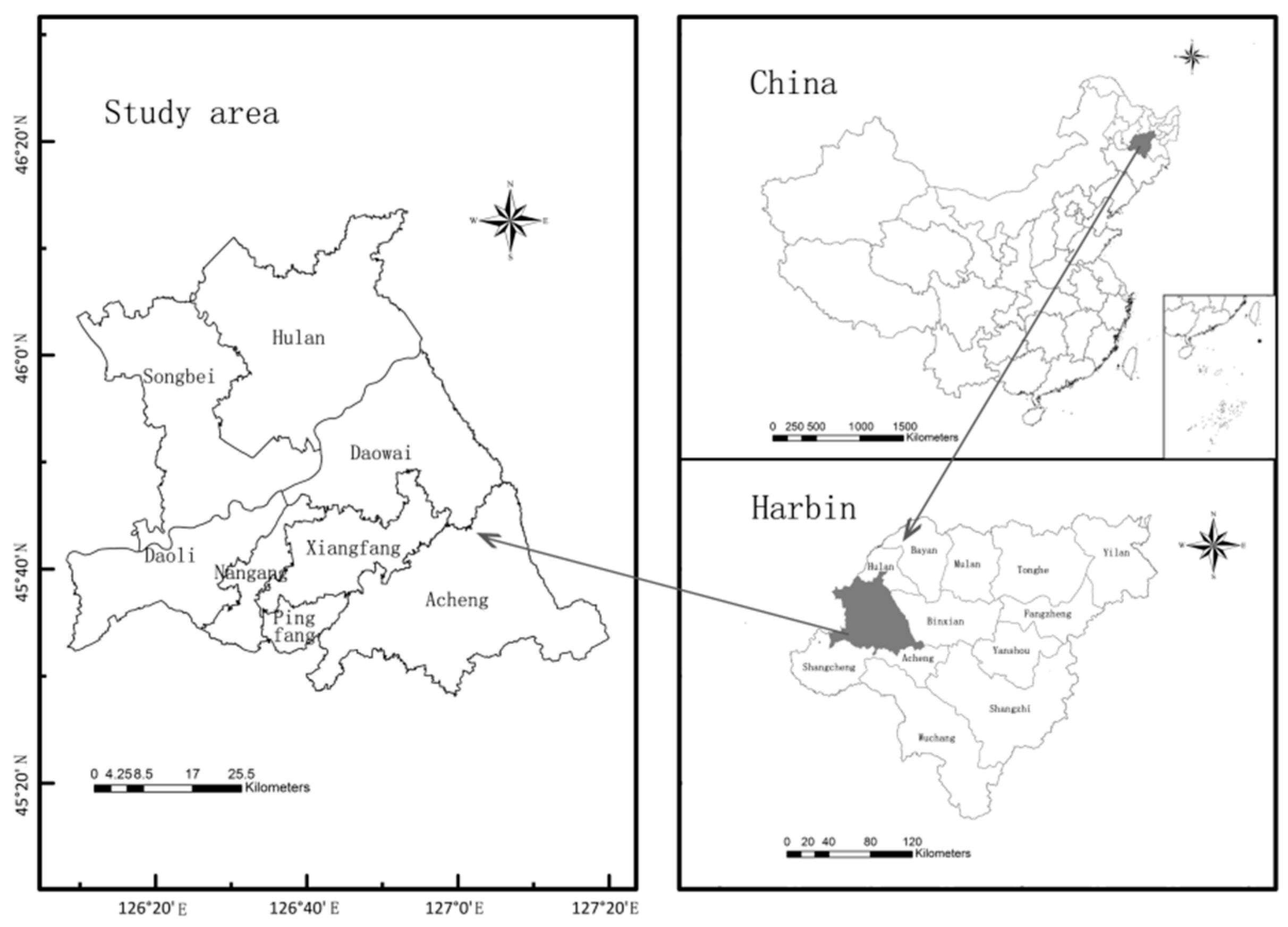
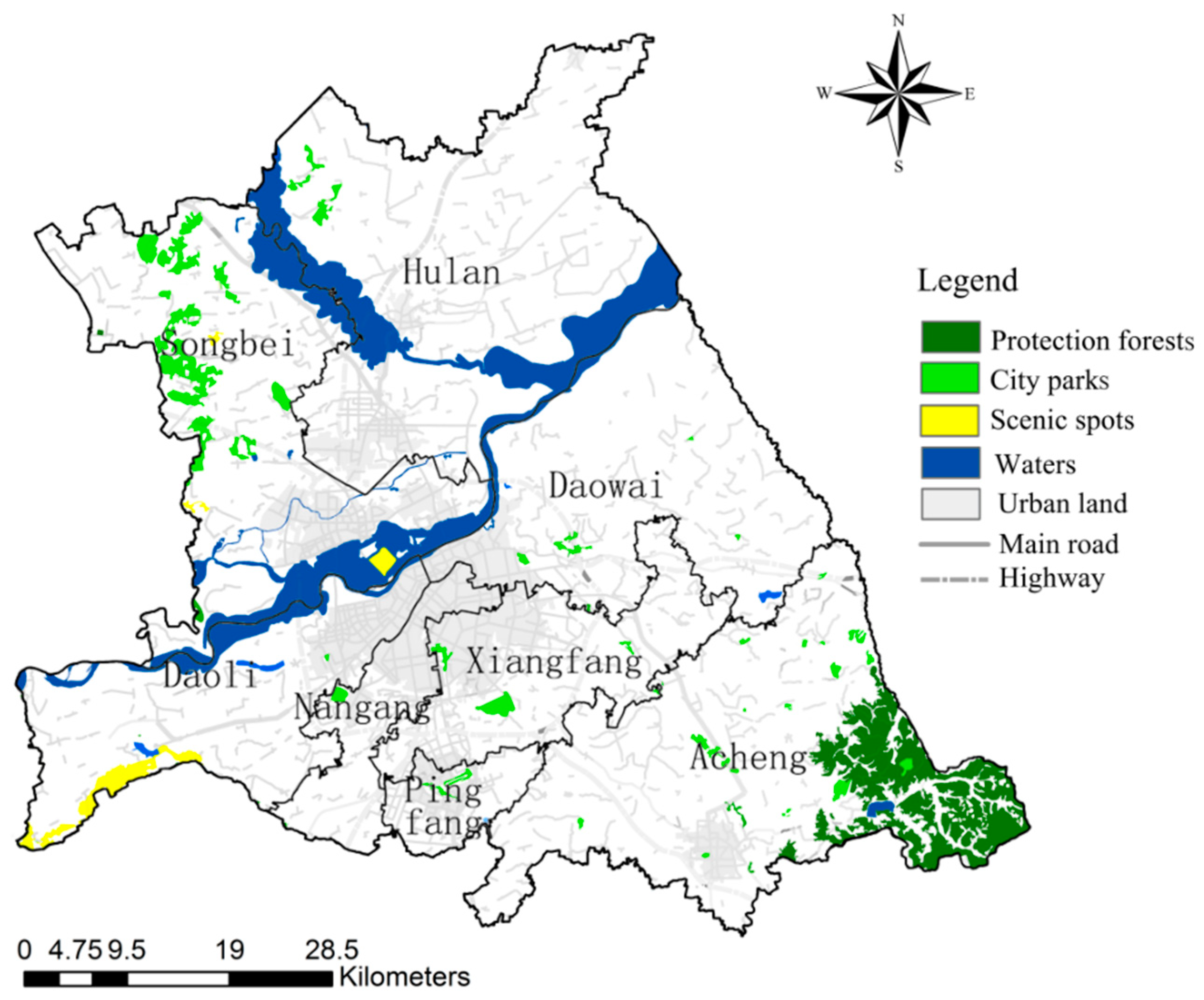
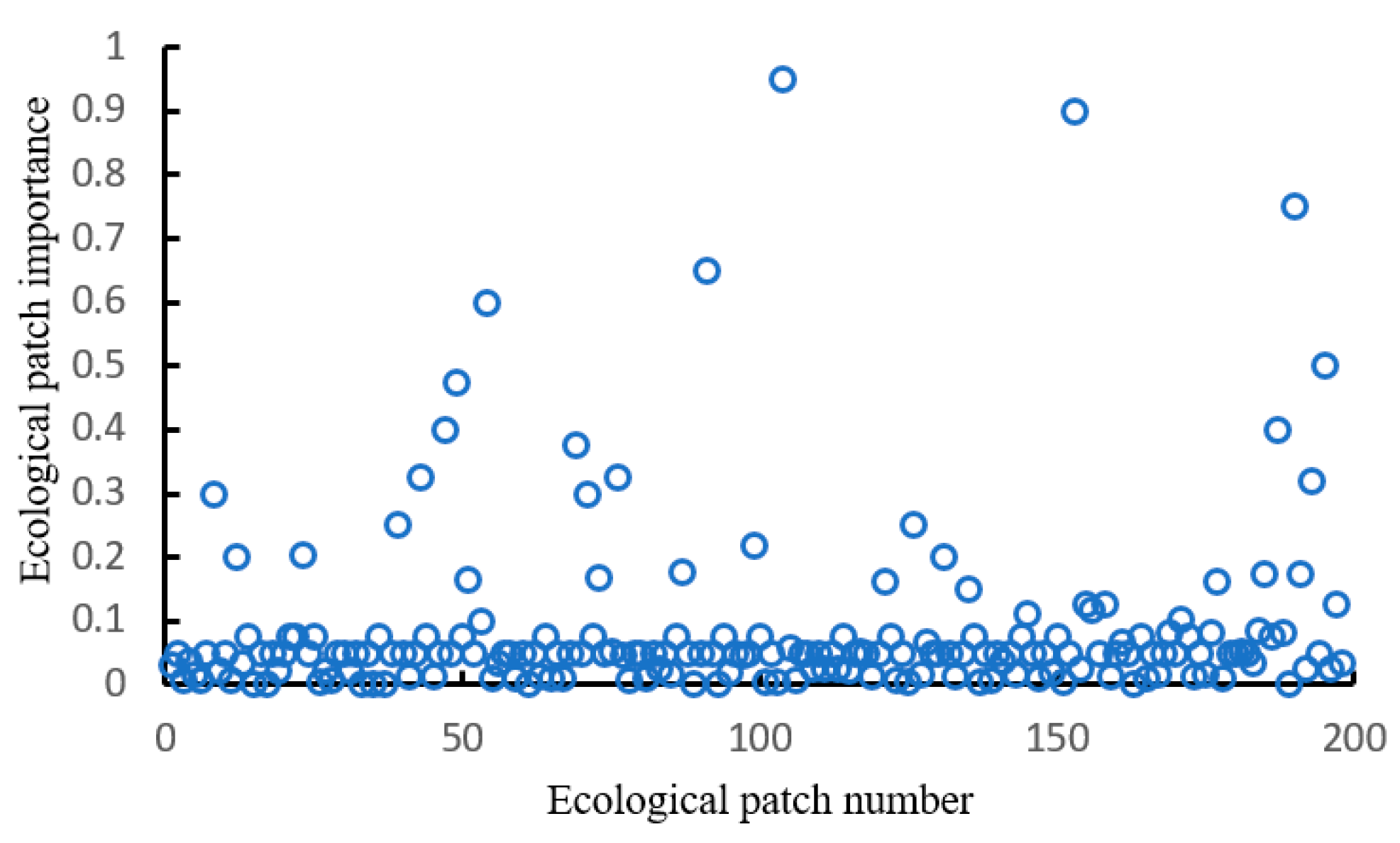

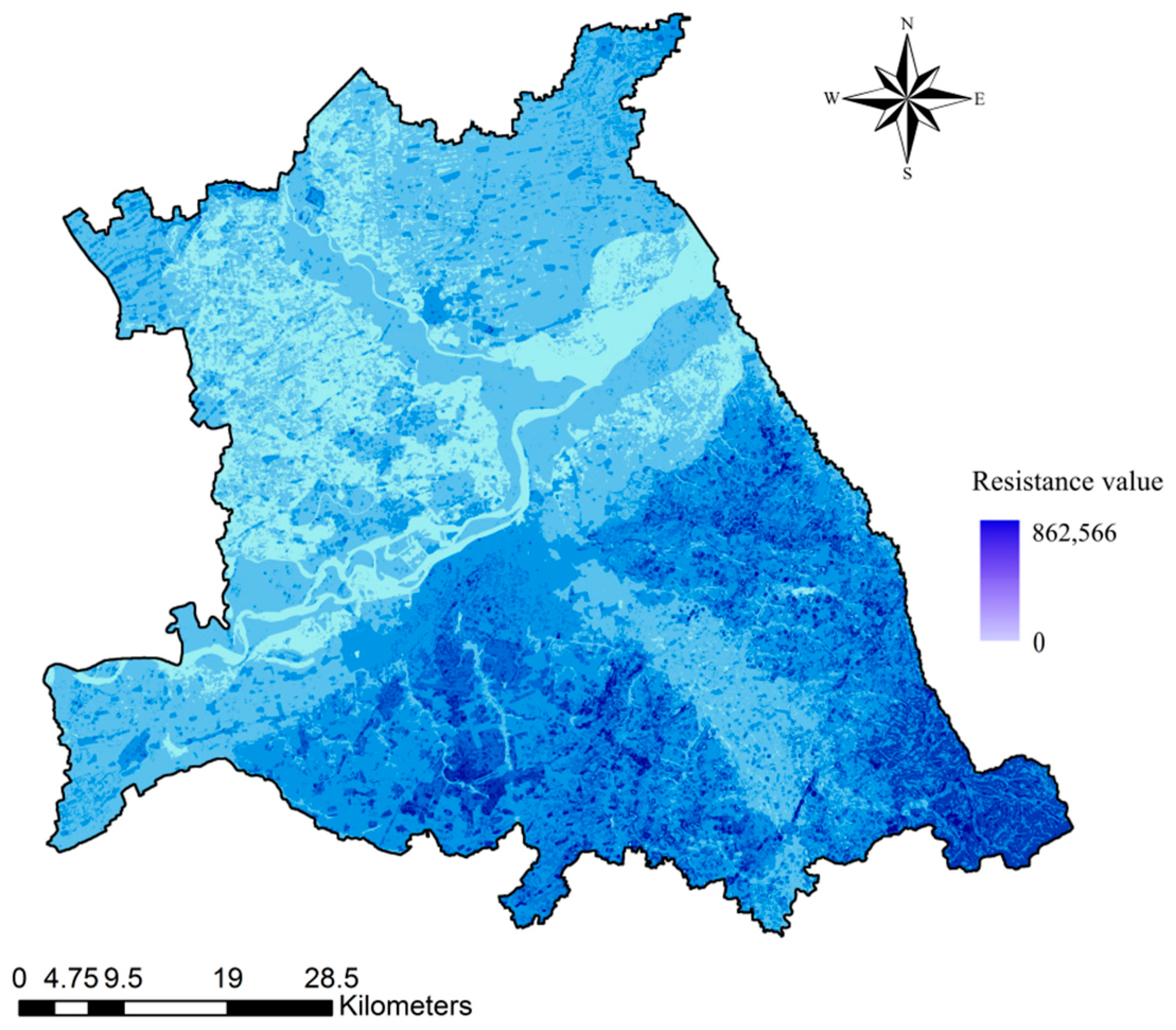
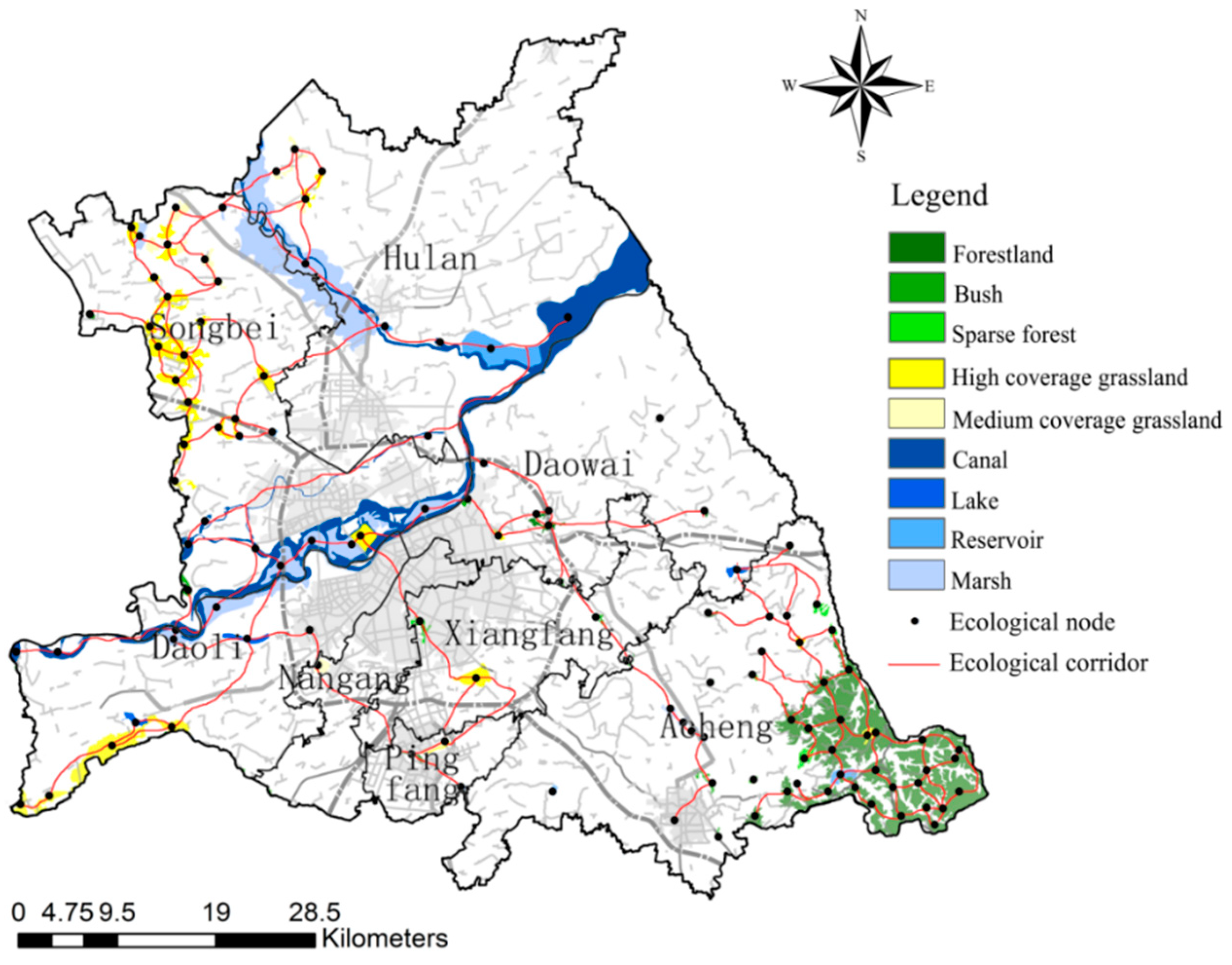

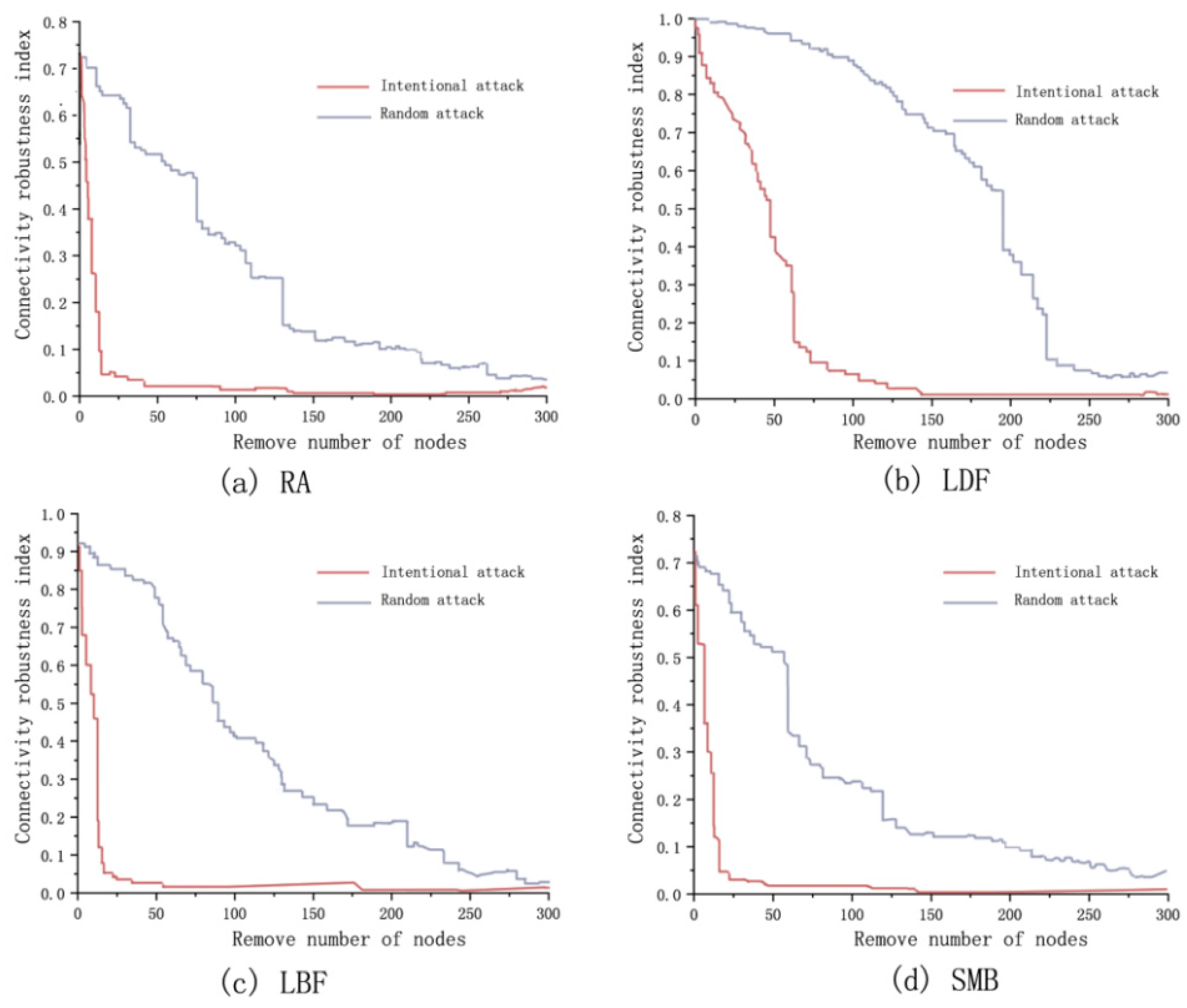

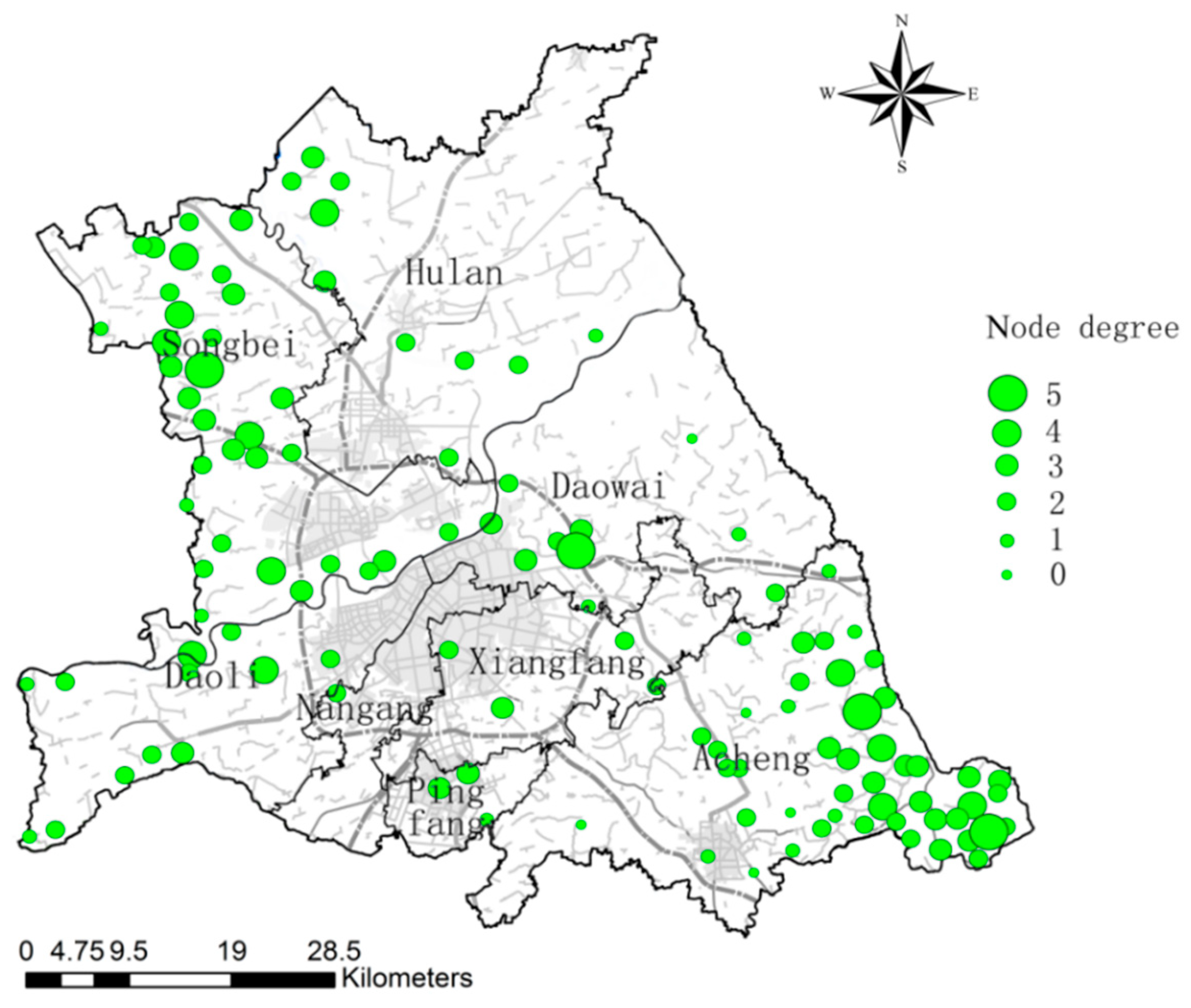
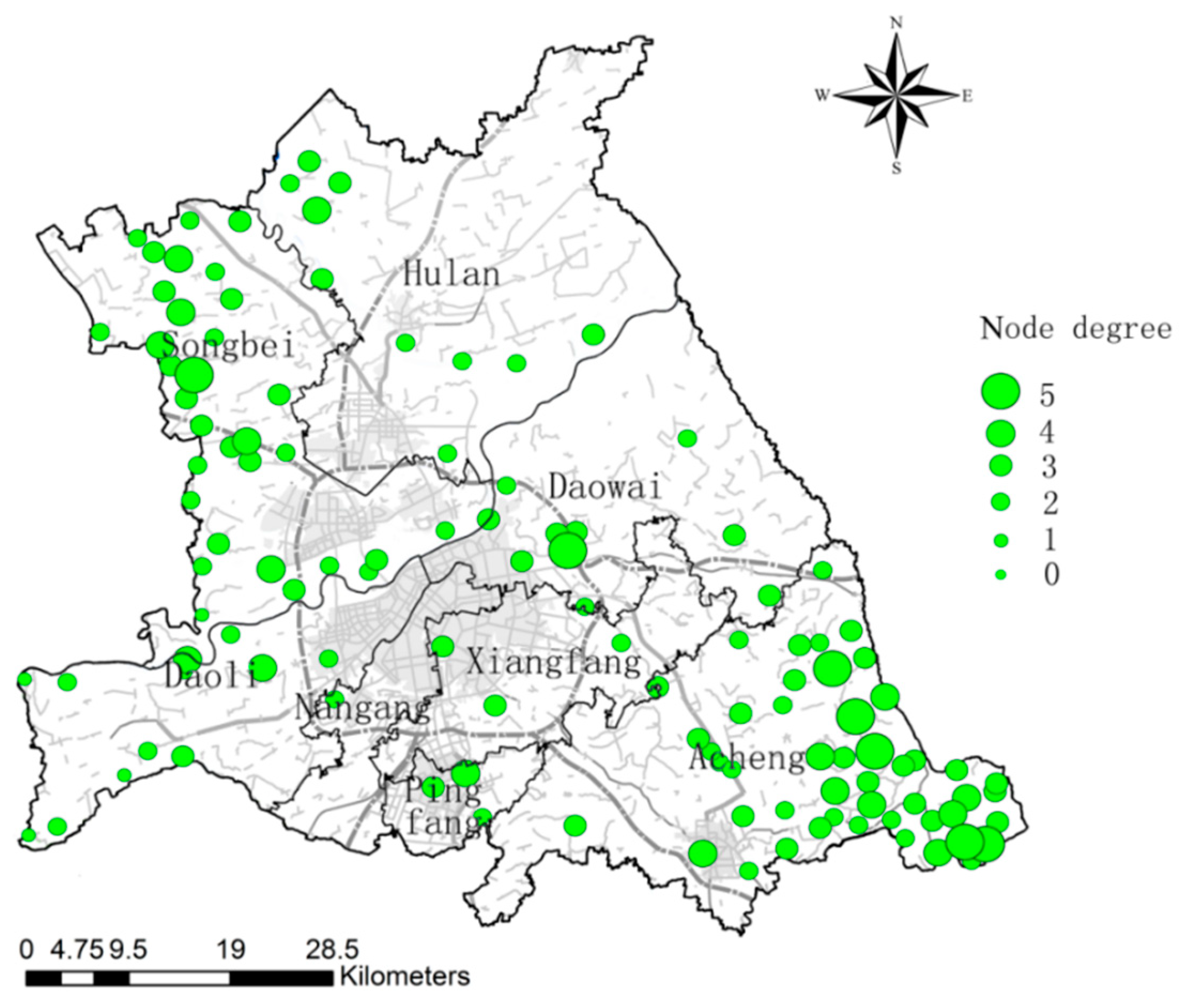

| District | NP (Pieces) | CA (ha) | PLAND (%) | LPI (%) | LSI (%) | COHESION (%) |
|---|---|---|---|---|---|---|
| Daoli | 19 | 6951.51 | 15.6621 | 8.2965 | 8.2608 | 99.3281 |
| Daowai | 12 | 10,946.16 | 17.7908 | 15.9749 | 4.4814 | 99.6878 |
| Xiangfang | 11 | 798.30 | 2.3375 | 1.2647 | 4.9206 | 97.3614 |
| Nangang | 6 | 222.48 | 1.3211 | 0.9214 | 2.9100 | 95.9299 |
| Pingfang | 5 | 269.10 | 2.9136 | 1.1518 | 6.1091 | 96.7406 |
| Songbei | 49 | 16,097.40 | 21.8475 | 14.6009 | 13.8865 | 99.5820 |
| Hulan | 20 | 13,858.92 | 14.5701 | 13.7796 | 5.5669 | 99.7068 |
| Acheng | 76 | 15,855.84 | 18.7051 | 16.8907 | 14.2214 | 99.7605 |
Publisher’s Note: MDPI stays neutral with regard to jurisdictional claims in published maps and institutional affiliations. |
© 2021 by the authors. Licensee MDPI, Basel, Switzerland. This article is an open access article distributed under the terms and conditions of the Creative Commons Attribution (CC BY) license (http://creativecommons.org/licenses/by/4.0/).
Share and Cite
Song, S.; Xu, D.; Hu, S.; Shi, M. Ecological Network Optimization in Urban Central District Based on Complex Network Theory: A Case Study with the Urban Central District of Harbin. Int. J. Environ. Res. Public Health 2021, 18, 1427. https://doi.org/10.3390/ijerph18041427
Song S, Xu D, Hu S, Shi M. Ecological Network Optimization in Urban Central District Based on Complex Network Theory: A Case Study with the Urban Central District of Harbin. International Journal of Environmental Research and Public Health. 2021; 18(4):1427. https://doi.org/10.3390/ijerph18041427
Chicago/Turabian StyleSong, Shuang, Dawei Xu, Shanshan Hu, and Mengxi Shi. 2021. "Ecological Network Optimization in Urban Central District Based on Complex Network Theory: A Case Study with the Urban Central District of Harbin" International Journal of Environmental Research and Public Health 18, no. 4: 1427. https://doi.org/10.3390/ijerph18041427





